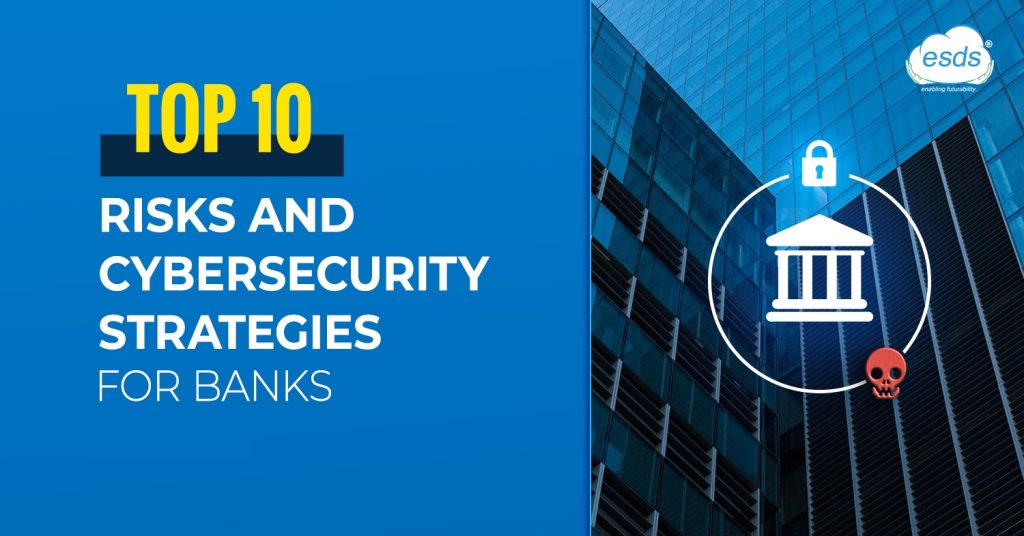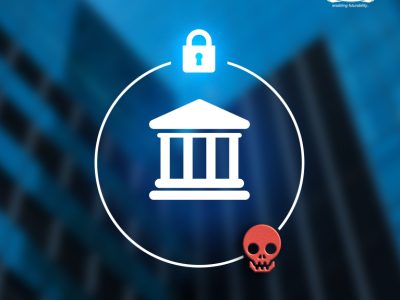Top 10 Risks and Cybersecurity Strategies for Banks in 2024
Introduction:
The banking industry has seen immense growth and transformation in the fast-evolving world of technology. However, with every leap in innovation, new challenges arise. As we delve deeper into 2024, banks face an increasingly complex cybersecurity landscape that demands stringent measures to safeguard sensitive information, protect customer data, and maintain trust. This blog will explore the top 10 risks and essential cybersecurity strategies for banks in 2023.

1. AI-based Attacks – Battling the Smart Threat
Artificial intelligence (AI) has enabled significant advancements but can also be exploited for malicious purposes. AI-driven attacks pose a unique challenge as they adapt and learn from the target’s behavior. To combat this, banks must adopt AI-powered defense mechanisms to detect and neutralize these evolving threats.
To defend against AI-driven attacks, banks can:
- Deploy AI-powered defense mechanisms that identify and respond to abnormal behavior in real-time for their websites or web applications. Banks can use vulnerability scanner tools like VTMScan.
- Utilize machine learning algorithms to continuously analyze network traffic and detect patterns associated with AI-based attacks.
- Collaborate with cybersecurity firms like ESDS, specializing in AI-based threat detection, to stay ahead of evolving attack techniques.
2. Ransomware – A Growing Concern

Ransomware attacks have increased, causing severe disruptions and financial losses for banks and their customers. Regular data backups, network segmentation, and employee awareness training are vital to thwarting ransomware attacks.
To counter ransomware threats, banks should:
- Establish and maintain regular data backups stored in offline and secure environments.
- Implement network segmentation to limit the lateral movement of ransomware within the network.
- Conduct simulated ransomware exercises to test incident response plans and ensure a swift recovery process.
3. Insider Threats – Securing from Within
Insider threats, intentional or unintentional, can lead to data leaks and security breaches. Strengthening access controls, monitoring employee activities, and promoting a culture of security awareness are essential components to minimize the risk of insider attacks.
To mitigate insider threats, banks can:
- Implement role-based access controls to ensure employees only have access to the data and systems necessary for their roles.
- Monitor user activities using behavior analytics to detect unusual patterns or unauthorized access.
- Foster a culture of security awareness through training programs and regular reminders about the importance of data protection.
- Implement a PAM solution and secure your organization’s sensitive data and systems.
4. Mobile Banking Vulnerabilities
The popularity of mobile banking makes it an attractive target for cybercriminals. Banks must prioritize securing mobile apps and implementing multi-factor authentication to ensure that customers’ financial transactions remain safe and secure.
For mobile banking security, banks should:
- Implement multi-factor authentication (MFA) for mobile app access to enhance user verification.
- Regularly update and patch mobile apps to address vulnerabilities and ensure compliance with security standards.
- Educate customers about secure mobile banking practices, such as avoiding public Wi-Fi.
5. Third-party Risks – Trust but Verify

Banks often collaborate with third-party vendors, exposing them to potential security risks.
To manage third-party risks, banks should:
- Conduct thorough security assessments of third-party vendors before entering into partnerships.
- Define clear security expectations and requirements in vendor contracts, including data protection and incident response protocols.
- Monitor third-party activities and conduct regular security audits to ensure compliance with agreed-upon security measures.
6. IoT Security Challenges
The Internet of Things (IoT) devices are revolutionizing how we interact with technology. However, they also introduce new entry points for cyber threats.
To address IoT-related vulnerabilities, banks can:
- Implement robust authentication mechanisms for IoT devices, such as certificates or biometric verification.
- Enforce regular firmware updates to ensure devices are protected against known vulnerabilities.
- Segregate IoT devices on separate networks to limit potential attacks from spreading to critical banking systems.
7. Data Privacy Compliance
With data breaches becoming more prevalent, regulators are tightening data privacy laws. Banks must prioritize compliance with regulations like the General Data Protection Regulation (GDPR) and ensure transparent data handling practices to build and maintain customer trust.
To ensure data privacy compliance, banks should:
- Appoint a dedicated data protection officer to oversee compliance with regulations like GDPR.
- Implement robust data encryption for at-rest and in-transit data to protect customer information.
- Establish transparent data handling practices, including precise consent mechanisms for data collection and usage.
8. Cloud Security Concerns
Cloud technology offers numerous benefits, but it also presents unique security challenges. Banks must implement robust encryption, continuous monitoring, and regular audits to secure data stored in the cloud.
For cloud security, banks should:
- Implement robust encryption protocols to safeguard data stored and transmitted in the cloud.
- Employ continuous monitoring and threat detection mechanisms to identify unauthorized access or unusual activities.
- Conduct regular third-party audits of the cloud service provider’s security practices to ensure compliance and data protection.
9. Social Engineering – The Human Factor

Social engineering remains a potent tool in the hands of cybercriminals. Banks must educate employees about the various forms of social engineering, such as phishing and pretexting, to prevent unauthorized access and data breaches.
To prevent social engineering attacks, banks should:
- Provide comprehensive training to employees on recognizing and responding to social engineering tactics.
- Conduct simulated phishing exercises to assess employees’ ability to identify and report suspicious emails.
- Establish strict authentication processes for sensitive transactions and account access to prevent unauthorized access.
10. Cryptojacking – A Silent Threat

Cryptocurrencies have gained momentum in recent years, and so has cryptojacking. It involves cybercriminals hijacking computer-processing power to mine cryptocurrency without the user’s knowledge. For banks, this can lead to compromised systems and performance issues. Implementing robust endpoint security, regular system scans, and educating employees about potential threats can help mitigate this risk.
To mitigate this risk, banks can:
- Implement robust endpoint security solutions that detect and prevent unauthorized mining activities.
- Conduct regular system scans using reputable anti-malware software to identify and remove cryptojacking scripts.
- Educate employees about the signs of crypto-jacking and the importance of avoiding suspicious websites and downloads.
Conclusion:
By proactively addressing these top 10 risks, banks can safeguard their assets, protect customer data, and maintain a reputation for trust and reliability. Staying one-step ahead of cyber threats requires cutting-edge technology, employee training, and a commitment to continuous improvement in cybersecurity. Together, let us build a safer and more secure future for the banking industry in 2023 and beyond.
- Decoding Generative AI: A Comprehensive Guide to Gartner’s Impact Radar - January 2, 2024
- 5 Best Practices for Cloud Security in 2024 - December 29, 2023
- 10 Best Machine Learning Ops Strategies for Cloud Environments in 2024 - December 29, 2023
